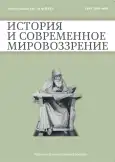К проблеме новой индустриализации и эволюции технологических укладов на Урале. Часть 1. Первичные практики
- Авторы: Литовский В.В.1
-
Учреждения:
- Институт экономики Уральского отделения Российской академии наук
- Выпуск: Том 4, № 2 (2022)
- Страницы: 12-19
- Раздел: Статьи
- URL: https://journals.rcsi.science/2658-4654/article/view/147218
- DOI: https://doi.org/10.33693/2658-4654-2022-4-2-12-19
- ID: 147218
Цитировать
Полный текст
Аннотация
Полный текст
Открыть статью на сайте журналаОб авторах
Владимир Васильевич Литовский
Институт экономики Уральского отделения Российской академии наук
Email: vlitovskiy1@yandex.ru
доктор географических наук, заведующий сектором размещения производительных сил и территориального планирования Института экономики Екатеринбург, Российская Федерация
Список литературы
- Арсеньев К. И. Статистические очерки России. СПб.: Тип. Имп. Акад. наук, 1848. 96 с.
- Алексеев В.В., Гаврилов Д.В. Металлургия Урала с древнейших времён до наших дней. М.: Наука, 2008. 886 с.
- Баканов, С. А. Угольная промышленность Урала: жизненный цикл отрасли от зарождения до упадка: монография. Челябинск: Энциклопедия, 2012. 328 с.
- Белл Дж. Грядущее постиндустриальное общество. Опыт социального прогнозирования. М.: Academia, 2004. 944 с.
- Гэлбрейт Дж. Новое индустриальное общество. Избранное. М.: Эксмо, 2008. 1200 с.
- Запарий В.В. Чёрная металлургия Урала XVIII-XX вв. Екатеринбург: УрО РАН, 2001. 304 с.
- Запарий В.В., Набойченко С.С. История цветной металлургии Урала во второй половине ХХ века. УМЦ - УПИ. Екатеринбург, 2010. 186 с.
- Камынин В.Д., Запарий В.В. О «новой индустриальной истории» (к постановке вопроса) // История и современное мировоззрение. 2019. № 1. С. 96-97.
- Колосовский Н.Н. Теория экономического районирования. М.: Мысль, 1969. 336 с.
- Литовский В.В. Невозобновляемые природные ресурсы Урала и пространственно-временные закономерности их вовлечения в хозяйственный оборот // Теоретико-географические основы формирования доминантного урало-арктического пространства и его инфраструктуры (для задач формирования многофункционального базисного опорного внутреннего и континентального моста России по оси «Север-Юг»). М.: ГЕОС, 2016. С.16-51.
- Литовский В.В. Гравиогеография Урала и сопряженных территорий М.: ГЕОС, 2020. 474 с.
- Литовский В.В. Концепция размещения в Арктике производительных сил на базе инфраструктуры второго уровня А. Э. Юницкого и пространственная модель транспортной сети «Полярное кружево» для «мобильных поселений» // Вестник МГТУ. Труды Мурманского государственного технического университета. 2016. Т. 19. № 2. С. 431-442.
- Металлургические заводы Урала XVII-XX вв.: Энциклопедия / глав. ред. В. В. Алексеев. Екатеринбург: Издательство «Академкнига», 2001. 536 с.
- Нечаев А. В. Неоиндустриализация России: стратегия технико-экономического развития: дис. кандидат наук: 08.00.01 - Экономическая теория. Санкт-Петербург: СПбГУ, 2020. 421 с
- Новая технологическая революция: вызовы и возможности для России. Экспертно-аналитический доклад /Под науч. ред. В.Н.Княгинина. М.: Центр стратегических разработок, 2017. 136 с.
- Новикова Н. В. Новая индустриализация: региональная парадигма. Екатеринбург: Изд-во Урал. гос. экон. ун-та, 2018. 261 с.
- Румянцев М. А. Неоиндустриализация российской экономики и новая промышленная революция /Социально-экономическое развитие России и Китая глазами российских и китайских экономистов. Колл. монография. СПб.: Скифия-принт, 2019. С. 32-52.
- Румянцева С. Ю. Неоиндустриализация России в контексте циклической экономической динамики // Новая индустриализация России: стратегические приоритеты страны и возможности Урала. Екатеринбург: Изд-во Урал. гос. экон. ун-та, 2018. С. 102-129.
- Сушкова И.А. Неоиндустриализация и механизм ее осуществления (теоретический аспект) // Инновационная деятельность. 2019. № 1. С. 61-68.
- Тархов С.А. Историческая эволюция административно-территориального и политического деления России / Регионализация и развитие России: географические процессы и проблемы. М.: Эдиториал УРСС, 2001. С. 191-213.
- Татаркин А.И., Романова О.А., Бухвалов Н.Ю. Новая индустриализация экономики России // Вестник УрФУ. Экономика и управление. 2014. №3. С.13-21.
- Zapariy V., Zapariy V. Strategies for industrial development in the context of Russia's modernization policy (1917-1941) / 5th International Multidisciplinary Scientific Conference on social sciences and arts SGEM 2018. Conference proceedings. 2018. P. 365-372.
Дополнительные файлы








